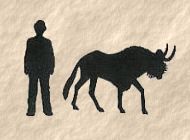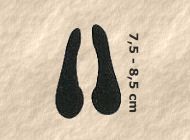 |
 |

Size

Footprint
|
Close this window to go
back to the previous page |
|
Description
|
Large, cattle like animals. Greyish-black,
assumes the colour of the soil at times when it wallows in the mud. Both
sexes have horns. |
|
Sexual dimorphism |
The males are usually darker and heavier and
has larger horns than the females. |
|
Habitat |
Enough edible grass, shade and water are
important requirements. Preferential grass occurs in mopani and thornveld as
well as in other types of woodland and open vleis. Avoids floodplains or
grassveld that is far from the shade of trees. |
|
Habits |
Forms herds which can number a few thousand.
Split into smaller herds in summer, moving apart in search of good grazing,
but when it becomes drier return to areas with permanent water. Mixed and
bachelor herds as well as solitary males can be distinguished. There is a
difinite hierarchy between males that is maintained by threatening behaviour.
Dangerous animals to hunt, a wounded buffalo may circle back, wait for the
hunter along its track and attack him. Grazes when it is cool and rests in
the shade during the hottest parts of the day. |
|
Voice |
Bellows like cattle or grunts when in fight. |
|
Breeding |
A single young is born in summer after a
gestation period of ± 11 months. |
|
Food |
Grass, drinks water regularly (Twice a day,
early morning and late afternoon if available). |
|
Mass |
♂ ± 785 kg
♀ n/a kg
|
|
Life expectancy |
± 23 years |
|
Length of horns |
Average ± 110 cm
Record 162,56 cm
|
|
Enemies |
n/a |
|
Also known as |
Buffel (Afrikaans)
Syncerus caffer caffer |
|
This
site is best viewed at 1024 X 768
Please report any problems to the Webmaster
Copyright © CoZania October 2004 |



